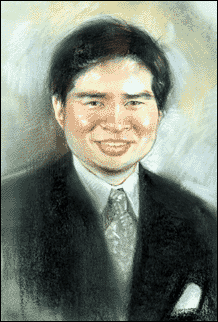INTERVIEW
Butterflies In China, Market Corrections In New York
Edgar Peters Talks About Chaos Theory
By Technical Analysis, Inc.
His work Chaos And Order In The Capital Markets ignited the imagination of traders and investors everywhere, and the way we viewed the markets changed. As PanAgora's chief investment officer and cochair of its investment committee, Edgar Peters is responsible for ensuring the integrity of the firm's investment strategies and product array. His insights into market dynamics and behavioral finance have not only added value to client portfolios but also stimulated the development of innovative investment technologies. An expert in tactical asset allocation strategies, he also manages PanAgora's asset allocation portfolio managers.STOCKS & COMMODITIES Editor Jayanthi Gopalakrishnan spoke to Edgar Peters on October 3, 2002.

You don't typically have a big capitulation selloff at the bottoms of bear markets ... they just sort of peter out.
How did you get interested in chaos theory?
As a quantitative manager, I had all the traditional schooling. As a practitioner, you find that the only way to make quantitative analysis work is to make a lot of adjustments, because there are a lot of problems with it. And also because I took classes with Harry Markowitz when I was in business school at Rutgers University, I knew a lot of the underlying assumptions that go into traditional quantitative management. After a while you find that those are fairly significant assumptions, and they can have significant problems. So in early 1987, when I read an article that chaos theorist James Gleick wrote for The New York Times Magazine, I got interested in the topic. I began to do research on my own.
What happened after that?
Over the next few years, I read a bunch of physics and mathematics papers. I applied some of that knowledge to do empirical research on the markets directly. In 1988, I wrote one paper for the Financial Analysts Journal in which I looked at fractal analysis, which I'd come across in a book by Jens Feder. Rescaled range analysis, which is what Feder wrote about, has the ability to determine whether a process had long memory. What happens now influences a process far into the future; it doesn't just go away.
But that's not conducive to traditional theories like the random walk.
When they talk about markets being random walks or having short memories, it means that what happens today doesn't really affect tomorrow that much, and it definitely doesn't affect things that happen a few days from now. That's critical to traditional quantitative techniques, because if you don't have that, a lot of the analysis doesn't work, or at least it becomes unreliable.
What did you do?
I conducted a test on market returns, and found that the market did
have a long memory. This prompted me to write a paper, which was published
a year later, as well as a book, Chaos And Order In The Capital Markets.
I thought it was important for people to be aware of the implications of
the long memory of the market, rather than having them slog through all
the physics papers. Then I got a request for a more technical explanation,
because the first book was supposed to be a conceptual introduction. So
I wrote the second book, Fractal Market Analysis. In that one, I
described the fractal market hypothesis to explain days of extreme volatility.
...Continued in the December 2002 issue of Technical Analysis of STOCKS & COMMODITIES
Excerpted from an article originally published in the December 2002 issue of Technical Analysis of STOCKS & COMMODITIES magazine. All rights reserved. © Copyright 2002, Technical Analysis, Inc.